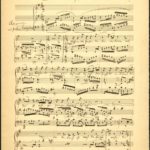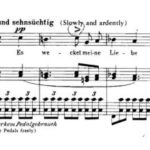
Composed
Premieres
- Lied 1: Fruhlingsmorgen, premiere Prague, 18-04-1886.
- Lied 2: Erinnerung, premiere Budapest, 13-11-1889.
- Lied 3: Hans und Grethe, premiere Prague, 18-04-1886. Later version of Lied 3: Maitanz im Grunen (Lieder fur ...

The first song in the Mahler collection, “Fruhlingsmorgen” (Spring morning), incorporates text written by Richard Leander. As notated in the piano part, the pianist is encouraged to use the pedals freely in order to produce a full and resonant of a sound.
Text: Richard Leander (Richard Volkmann (1830-1889)).
Score ...

The third song in the collection, “Hans und Grethe” is a wonderful mixture of waltz-like fervor and sublime self-introspection. Many of Mahler’s early songs provided inspiration for later symphonic works; the opening of “Hans und Grethe” was eventually used in the second movement of his first symphony. The dancelike structure ...


